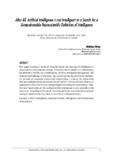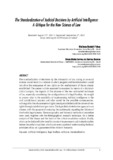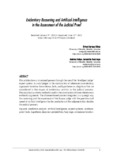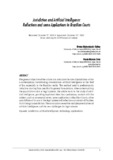Mostrar el registro sencillo del ítem
After All, Artificial Intelligence is not Intelligent: in a Search for a Comprehensible Neuroscientific Definition of Intelligence
Al fin y al cabo, la inteligencia artificial no es inteligente: en la búsqueda de una definición neurocientífica comprensible de la inteligencia;
Afinal de contas, a inteligência artificial não é inteligente: à procura de uma definição neurocientífica compreensível da inteligência
| dc.contributor.author | Divino, Sthéfano | spa |
| dc.date.accessioned | 2023-05-16T01:11:16Z | |
| dc.date.available | 2023-05-16T01:11:16Z | |
| dc.date.created | 2022-12-20 | |
| dc.identifier.issn | 1692-2530 | |
| dc.identifier.uri | http://hdl.handle.net/11407/7799 | |
| dc.description | This paper explores a series of thoughts about the meaning of intelligence in neuroscience and computer science. This work aims to present an understandable definition that fits our contemporary artificial intelligence background. The research methodology of this essay lies in existing theories of artificial intelligence, focused on computer science and neuroscience. I analyze the relationship between intelligence and neuroscience and Hawkin s Thousand Brains Theory, an approach to show what it is an intelligent agent according to neuroscience. Here, the main result relies on the verification that intelligence is only possible in the neocortex. According to this result, the study performs a second critical analysis aiming to demonstrate why there is no artificial intelligence today. | eng |
| dc.description | Este trabajo explora una serie de reflexiones sobre el significado de la inteligencia en la neurociencia y la informática. El objetivo de este trabajo es presentar una definición comprensible que se ajuste a nuestro entorno contemporáneo de inteligencia artificial. Se analiza la relación entre la inteligencia y la neurociencia y presento la teoría de los mil cerebros de Hawkins, un enfoque para mostrar qué es un agente inteligente según la neurociencia. Aquí, el principal resultado se basa en la comprobación de que la inteligencia sólo es posible en el neocórtex. De acuerdo con este resultado, el estudio hace un segundo análisis crítico con el objetivo de demostrar por qué no existe la inteligencia artificial en la actualidad. La metodología de investigación de este ensayo se basa en las teorías existentes sobre la inteligencia artificial, centradas en la informática y la neurociencia. | spa |
| dc.description | Este trabalho explora uma série de reflexões sobre o significado da inteligência na neurociência e informática. O objetivo desse trabalho é apresentar uma definição compreensível que se ajuste ao nosso ambiente contemporâneo de inteligência artificial. Analisa-se a relação entre inteligência e a neurociência e a teoria dos mil cérebros de Hawkins, uma abordagem para mostrar que é um agente inteligente segundo a neurociência. O principal resultado se baseia na comprovação de que a inteligência só é possível na neocórtex. De acordo com esse resultado, o estudo faz uma segunda análise crítica com o objetivo de demonstrar por que não existe inteligência artificial na atualidade. A metodologia aplicada a esta pesquisa baseou-se nas teorias existentes sobre a inteligência artificial, centradas na informática e na neurociência. | por |
| dc.format.extent | p. 1-21 | |
| dc.format.medium | Electrónico | |
| dc.format.mimetype | ||
| dc.format.mimetype | application/pdf | |
| dc.language.iso | eng | |
| dc.publisher | Medellín | |
| dc.publisher | Universidad de Medellín | |
| dc.relation.uri | https://revistas.udem.edu.co/index.php/opinion/article/view/4043 | |
| dc.rights.uri | http://creativecommons.org/licenses/by-nc-sa/4.0/ | |
| dc.source | Opinión Jurídica, Vol 21 No 46 (2022): Special Edition: relationship between Law and New Technologies | spa |
| dc.source | Opinión Jurídica, Vol. 21 Núm. 46 (2022): Edición especial: relación entre derecho y nuevas tecnologías, 1-21 | spa |
| dc.source | Opinión Jurídica, Vol 21 No 46 (2022): Special Edition: relationship between Law and New Technologies, 1-21 | eng |
| dc.subject | Artificial intelligence | eng |
| dc.subject | Computer science | eng |
| dc.subject | Machine learning | eng |
| dc.subject | Neuroscience | eng |
| dc.subject | Inteligencia artificial | spa |
| dc.subject | Informática | spa |
| dc.subject | Inteligencia | spa |
| dc.subject | Aprendizaje automático | spa |
| dc.subject | Neurociencia | spa |
| dc.subject | Inteligência artificial | por |
| dc.subject | Informática | por |
| dc.subject | Inteligência | por |
| dc.subject | Aprendizagem automática | por |
| dc.subject | Neurociência | por |
| dc.title | After All, Artificial Intelligence is not Intelligent: in a Search for a Comprehensible Neuroscientific Definition of Intelligence | eng |
| dc.title | Al fin y al cabo, la inteligencia artificial no es inteligente: en la búsqueda de una definición neurocientífica comprensible de la inteligencia | spa |
| dc.title | Afinal de contas, a inteligência artificial não é inteligente: à procura de uma definição neurocientífica compreensível da inteligência | por |
| dc.identifier.doi | https://doi.org/10.22395/ojum.v21n46a9 | |
| dc.relation.citationvolume | 21 | |
| dc.relation.citationissue | 46 | |
| dc.relation.citationstartpage | 1 | |
| dc.relation.citationendpage | 21 | |
| dc.audience | Comunidad Universidad de Medellín | |
| dc.audience | Interés general | |
| dc.publisher.faculty | Facultad de Derecho | |
| dc.coverage | Lat: 06 15 00 N degrees minutes Lat: 6.2500 decimal degreesLong: 075 36 00 W degrees minutes Long: -75.6000 decimal degrees | |
| dc.type.eng | Article | |
| dc.relation.references | Atkinson, J. (2021, July 26th). Tesla s Autopilot Misunderstood the Moon For A Yellow Traffic Light. Video: Automatic. Swords Today. https://swordstoday.ie/teslas-autopilot-misunderstood-the-moon-for-a-yellowtraffic-light-video-automatic/ | |
| dc.relation.references | Barton, R. A. (1996). Neocortex size and behavioural ecology in primates. Proceedings of the Royal Society of London, 263(1367), 173-177. | |
| dc.relation.references | Beer, J. M., Fisk, A. D. and Rogers, W. A. (2014). Toward a framework for levels of robot autonomy in human-robot interaction. Journal of human-robot interaction, 3(2), 74-99. https://doi.org/10.5898%2FJHRI.3.2.Beer | |
| dc.relation.references | Binder, J. R. (2017). Current controversies on Wernicke s area and its role in language. Current neurology and neuroscience reports, 17(8), 1-10. | |
| dc.relation.references | Bostrom, N. and Yudkowsky, E. (2011). The ethics of artificial intelligence. In K. Frankish and W. M. Ramsey (eds.), The Cambridge Handbook of Artificial Intelligence (316-334). Cambridge University Press. | |
| dc.relation.references | Bostrom, N. (2014). Superintelligence. Oxford University Press. | |
| dc.relation.references | Brayne, S. (2020). Predict and surveil: Data, discretion, and the future of policing. Oxford University Press. | |
| dc.relation.references | Byrne, R. W., and Corp, N. (2004). Neocortex size predicts deception rate in primates. Proceedings of the Royal Society of London B, 271(1549), 1693-1699. | |
| dc.relation.references | Crawford, K. (2021). The Atlas of AI. Yale University Press. | |
| dc.relation.references | Crick, F. H. (1979). Thinking about the brain. Scientific American, 241(3), 219-233. | |
| dc.relation.references | Davis, R., Shrobe, H. and Szolovits, P. (1993). What is a knowledge representation? AI magazine, 14(1), 17-33. https://doi.org/10.1609/aimag.v14i1.1029 | |
| dc.relation.references | Deaner, R. O., Isler, K., Burkart, J. and Van Schaik, C. (2007). Overall brain size, and not encephalization quotient, best predicts cognitive ability across non-human primates. Brain, behavior and evolution, 70(2), 115-124. | |
| dc.relation.references | Edelman, G. M. and Mountcastle, V. B. (1978). The mindful brain: cortical organization and the group-selective theory of higher brain function. MIT Press. | |
| dc.relation.references | Etard, O., Mellet, E., Papathanassiou, D., Benali, K., Houdé, O., Mazoyer, B. and Tzourio-Mazoyer, N. (2000). Picture naming without Broca s and Wernicke s area. Neuroreport, 11(3), 617-622. | |
| dc.relation.references | Felleman, D. J. and Van Essen, D. C. (1991). Distributed hierarchical processing in the primate cerebral cortex. Cerebral cortex, 1(1), 1-47. https://doi.org/10.1093/cercor/1.1.1-a | |
| dc.relation.references | Franklin, S. and Graesser, A. (1997). Is it an Agent, or just a Program?: A Taxonomy for Autonomous Agents. In J. P. Müller, M. J. Wooldridge and N. R. Jennings (eds), Intelligent Agents III Agent Theories, Architectures, and Languages (pp. 21-35). Springer. https://doi.org/10.1007/BFb0013570 | |
| dc.relation.references | Gharbi, R. B., Elsharkawy, A. M. and Karkoub, M. (1999). Universal neural-network-based model for estimating the PVT properties of crude oil systems. Energy and fuels, 13(2), 454-458. https://doi.org/10.1021/ef980143v | |
| dc.relation.references | Haggard, P. (2017). Sense of agency in the human brain. Nature Reviews Neuroscience, 18(4), 196-207. | |
| dc.relation.references | Hawkins, J. and Ahmad, S. (2016). Why neurons have thousands of synapses, a theory of sequence memory in neocortex. Frontiers in Neural Circuits, 10. https://doi.org/10.3389/fncir.2016.00023 | |
| dc.relation.references | Hawkins, J. (2021). A thousand brains: A new theory of intelligence. Basic Books. | |
| dc.relation.references | Hinton, G. F. (1981). A parallel computation that assigns canonical object-based frames of reference. In A. Drinan (ed.), Proceedings of the 7th international joint conference on Artificial intelligence-Volume 2 (pp. 683-685). Morgan Kaufmann Publishers Inc. | |
| dc.relation.references | Huang, H. M., Pavek, K., Ragon, M., Jones, J., Messina, E. and Albus, J. (2007). Characterizing unmanned system autonomy: Contextual autonomous capability and level of autonomy analyses. In G. R. Gerhart, D. W. Gage and C. M. Shoemaker (eds.), Unmanned Systems Technology IX. Proceedings Volume 6561. Defense and Security Symposium | 9-13 April 2007. International Society for Optics and Photonics. | |
| dc.relation.references | Gil, V., Nocentini, S. and Del Río, J. A. (2014). Historical first descriptions of Cajal Retzius cells: from pioneer studies to current knowledge. Frontiers in neuroanatomy, 8, 32, 1-9. | |
| dc.relation.references | Kim, D., and Thayer, S. A. (2001). Cannabinoids inhibit the formation of new synapses between hippocampal neurons in culture. Journal of Neuroscience, 21(10), RC146. https://doi.org/10.1523/JNEUROSCI.21-10-j0004.2001 | |
| dc.relation.references | Konflanz, D. M. (2019). Investigating hierarchical temporal memory networks applied to dynamic branch prediction [undergraduate thesis, Universidade Federal da Fronteira Sul]. Digital Repository. https://rd.uffs.edu.br/handle/prefix/3374 | |
| dc.relation.references | Li, W., Ma, L., Yang, G. and Gan, W. B. (2017). REM sleep selectively prunes and maintains new synapses in development and learning. Nature neuroscience, 20(3), 427-437. | |
| dc.relation.references | Lindenfors, P. (2005). Neocortex evolution in primates: the social brain is for females. Biology letters, 1(4), 407-410. | |
| dc.relation.references | Luck, M. and d Inverno, M. (1995, June). A Formal Framework for Agency and Autonomy. In L. Gasser and V. Lesser (eds.), Proceedings of the First International Conference on Multiagent Systems (pp. 254-260). MIT Press. | |
| dc.relation.references | Luck, M. and d Inverno, M. (2001). A conceptual framework for agent definition and development. The Computer Journal, 44(1), 1-20. | |
| dc.relation.references | Markman, A. B. (2013). Knowledge representation. Psychology Press. | |
| dc.relation.references | Michaud, A. (2016). Intelligence and Early Mastery of the Reading Skill. Journal of Biometrics and Biostatistics, 7(4). https://doi.org/10.4172/2155-6180.1000327 | |
| dc.relation.references | Naeser, M. A., Helm-Estabrooks, N., Haas, G., Auerbach, S. and Srinivasan, M. (1987). Relationship between lesion extent in Wernicke s area on computed tomographic scan and predicting recovery of comprehension in Wernicke s aphasia. Archives of Neurology, 44(1), 73-82. | |
| dc.relation.references | Ogawa, M., Miyata, T., Nakajima, K., Yagyu, K., Seike, M., Ikenaka, K., Yamamoto, H. and Mikoshiba, K. (1995). The reeler gene-associated antigen on Cajal-Retzius neurons is a crucial molecule for laminar organization of cortical neurons. Neuron, 14(5), 899-912. https://doi.org/10.1016/0896-6273(95)90329-1 | |
| dc.relation.references | Qiu, Y., Garg, D., Zhou, L., Kharangate, C. R., Kim, S. M. and Mudawar, I. (2020). An artificial neural network model to predict mini/micro-channels saturated flow boiling heat transfer coefficient based on universal consolidated data. International Journal of Heat and Mass Transfer, 149. https://doi.org/10.1016/j.ijheatmasstransfer.2019.119211 | |
| dc.relation.references | Ramón Y Cajal, S. (1923). Recuerdos de mi vida. Imprenta de Juan Pueyo. | |
| dc.relation.references | Russell, S. J. and Norvig, P. (2010). Artificial Intelligence-A Modern Approach (3. internat. ed.) Pearson Education. | |
| dc.relation.references | Shrestha, Y. R., Ben-Menahem, S. M. and Von Krogh, G. (2019). Organizational decision-making structures in the age of artificial intelligence. California Management Review, 61(4), 66-83. | |
| dc.relation.references | Sun, Q. and Ertekin, T. (2015, April 27th-30th). The development of artificial-neural-network-based universal proxies to study steam assisted gravity drainage (SAGD) and cyclic steam stimulation (CSS) processes [paper presented In Society of Petroleum Engineers SPE Western Regional Meeting]. Garden Grove, California, USA. https://doi.org/10.2118/174074-MS | |
| dc.relation.references | Sutton, R. S., and Barto, A. G. (1998). Reinforcement learning: an introduction. The MIT Press. | |
| dc.relation.references | Tehovnik, E. J. and Slocum, W. M. (2004). Behavioural state affects saccades elicited electrically from neocortex. Neuroscience and Biobehavioral Reviews, 28(1), 13-25. https://doi.org/10.1016/j.neubiorev.2003.10.001 | |
| dc.relation.references | Yokoi, A. and Diedrichsen, J. (2019). Neural organization of hierarchical motor sequence representations in the human neocortex. Neuron, 103(6), 1178-1190. https://doi.org/10.1016/j.neuron.2019.06.017 | |
| dc.relation.references | Zemel, R. S., Mozer, M. C. and Hinton, G. E. (1989). TRAFFIC: Recognizing objects using hierarchical reference frame transformations. In D. S. Touretzky (ed.), Advances in neural information processing systems (pp. 266-273). Morgan Kaufmann Publishers Inc. https://dl.acm.org/doi/10.5555/2969830.2969863 | |
| dc.rights.creativecommons | Attribution-NonCommercial-ShareAlike 4.0 International | |
| dc.identifier.eissn | 2248-4078 | |
| dc.type.coar | http://purl.org/coar/resource_type/c_6501 | |
| dc.type.version | info:eu-repo/semantics/article;info:eu-repo/semantics/publishedVersion | |
| dc.type.version | info:eu-repo/semantics/publishedVersion | |
| dc.type.local | Artículo científico | |
| dc.type.driver | info:eu-repo/semantics/article | |
| dc.identifier.reponame | reponame:Repositorio Institucional Universidad de Medellín | |
| dc.identifier.repourl | repourl:https://repository.udem.edu.co/ | |
| dc.identifier.instname | instname:Universidad de Medellín |





